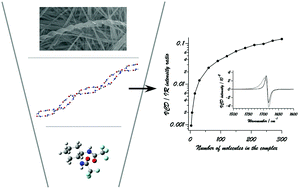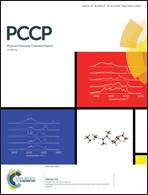Intermediate length-scale chirality related to the vibrational circular dichroism intensity enhancement upon fibril formation in a gelation process†
Abstract
Chiro-optical spectroscopic methods, such as vibrational circular dichroism (VCD) spectroscopy, are regarded as useful measures that provide us information on the structural properties of chiral species, but for correct interpretation of the measured spectra, appropriate modeling that can be compared with the observed spectra is essential. In the present study, the origin of the VCD intensity enhancement observed upon fibril formation in a gelation process is examined theoretically. Comparing with the observed spectroscopic feature and also with the observed scanning electron microscope (SEM) image, it is derived that there are at least three hierarchical tiers of chirality in the gel. The VCD intensity enhancement originates from one of them on the ∼50 nm length scale, which consists of a co-axial antiparallel right-handed double helical structure that persistently continues over ∼100 molecules, indicating that the intermediate length-scale fibril formation plays a crucial role in the VCD intensity enhancement, in a way similar to some fibril-forming peptides examined previously. The time course of the gelation process observed by the time dependence of the VCD intensity is also shown and discussed.

- This article is part of the themed collection: 2018 PCCP HOT Articles


 Please wait while we load your content...
Please wait while we load your content...